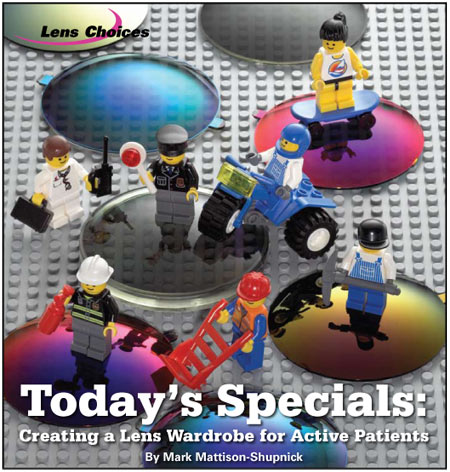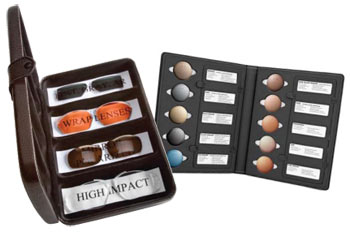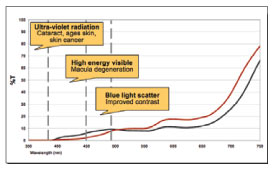
Photograph by Ned Matura
One of the most frequently discussed topics among dispensing opticians is how to sell a patient multiple pairs of eyewear. Often, the conversation centers around the concept of lifestyle dispensing, which involves recommending eyewear that’s appropriate for specific activities. The simplest example of this approach is to create a basic eyewear wardrobe according to function such as streetwear, dresswear, sports and safety.
 This a good starting point, since most patients understand that one pair of eyewear won’t work for all activities. Yet this approach is inherently limited because it is largely based upon frame selection. The next step is to introduce the idea of a lens wardrobe.
This a good starting point, since most patients understand that one pair of eyewear won’t work for all activities. Yet this approach is inherently limited because it is largely based upon frame selection. The next step is to introduce the idea of a lens wardrobe.
A good way to start building the patient’s lens wardrobe is to provide them with a four-place case (such as those available from Hard Case) and use it to ensure the patient has the right lenses, those with the best functionality for every special activity (in the right frames of course). Step one is to uncover the activity (sport, hobby, action). Step two is to define the functionality wanted. Then it’s possible to suggest the wardrobe of active, special and functional lenses, each geared to the patient’s visual needs when performing specific tasks.
To uncover the activity and the functionality required, ask a series of questions such as: What are your favorite sports activities in which you participate? Are particular things difficult to do? If you drive to and from work, is vision comfortable during those times? Do anything dangerous to your eyes, hobbies, at work, in your free time? Participate in any spectator sports—what are typical conditions, weather and visual requirements? Tell me about your typical day—during the week, after work, on weekends—do your lenses work as well at all those times? What were the best lenses you ever had—the worst and why? These questions unearth many things about the patient. It tells you visual activity; it also defines for the patient the areas in which they can identify a vision need (function, comfort, protection) and makes it easier for you to help list their options and describe the benefits. Remember, patients buy benefits. Lens benefits answer visual activity needs.

Defining Function and Protection
Impact is easily understood and can be addressed with polycarbonate or Trivex lenses. However, if the task requires that the sunglasses are also safety rated to meet the ANSI Z87.1 standard, then the lenses and frame must meet that standard. (Refer to the June, 2008 CE course at 2020mag.com, “Eye Protective Sunwear—Why It Should Be ANSI Z87 Safety Certified.”)
Ultra-violet has also been shown to cause cataracts, premature aging of the skin and skin cancers so it is understood by ECPs that active eyewear should be 100 percent UVA and UVB absorptive. All of the following are 100 percent UV absorbing: polycarbonate, all high-index greater than 1.59, all polarized and photochromics except standard plastic (absorbs 85 to 90 percent UV). But even plastic can be dyed to be 100 percent UV absorptive. Contact manufacturers and your lab for the lenses that can meet your patient’s standards.
High-energy visible light wavelengths, to about 450nm, has more recently been implicated in the incidence of macula degeneration. Like UV, radiation is accumulated in the crystalline lens and blue light seems to worsen the oxidative damage that has occurred in the retina over the years; it is particularly toxic to the aging retina. Aged retinas, or those prone to AMD, may not be able to repair even low-grade damage caused by visible or blue light so a number of researchers also believe it is important to protect younger eyes that lack the yellowing of the crystalline lens.
Blue light, the shorter wavelengths to about 480nm, are scattered by particles in the air like smog, dust and fog. Removing these wavelengths improves contrast and can improve the effective recognition and vision of individuals. Use colors like yellow, amber, brown and green to reduce blue and improve contrast.
Lens color and function can be determined in part by the transmission curve of the lens. In this example of a transmission curve for gray and brown polarized lenses, they also absorb all the UV and most of the high-energy visible and blue wavelengths. These lenses are protective and can increase contrast. Ask your vendors for explanations of how their filter lenses work.
Getting Into Action
Unlike other products, lenses for action sports seem to be more task-specific and involve personal preference. Gender doesn’t usually matter. Sport, hobby, need and personality play a bigger role. So, choose the right fitting frame, discuss lens options and build that wardrobe.
The Bottom Line
There are almost no limits to the ways a lens wardrobe can be assembled. It’s up to astute dispensers to recognize their patients’ needs and then recommend appropriate lenses. Explaining the benefits of wearing different frames and lenses geared to specific funtions makes good sense, both clinically and businesswise.











